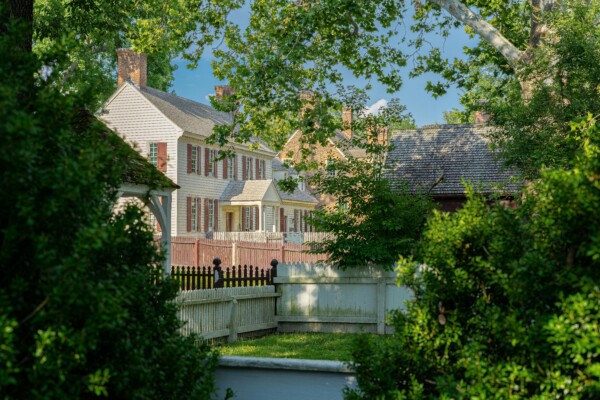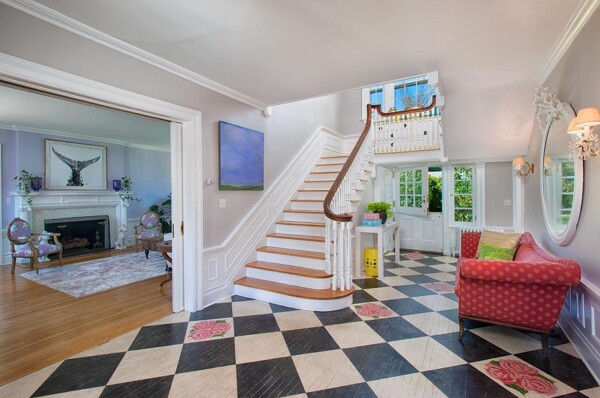How to Improve a Staircase in a Colonial Home (Without Ruining the Look)
Colonial staircases are known for their symmetry, turned wood balusters, and hand-crafted details. If yours is worn or outdated, upgrading it while preserving its original glamour can boost safety, style, and home value. This guide walks you through how to improve a staircase in a Colonial home with design tips, repair options, and clear guidance on when to restore versus replace.

Exterior of Historic Colonial Home with Symmetrical Design
The exterior of a Colonial home sets the tone for interior details like staircases and entryways.
Understand Colonial Staircase Design
Colonial-era and Colonial Revival homes are known for simplicity. The main staircase in these homes is often centrally located and a key feature, aligning with the front door. Original Colonial staircases typically include the following:
Understanding these elements helps you upgrade Colonial stairs in a way that feels like an extension of the original design.

Colonial Home Staircase with Checkered Floor Entryway
A Colonial-style staircase enhanced with period-appropriate balusters and a classic checkered floor.
Common Problems With Older Colonial Stairs
Over time, staircases in Colonial homes can develop issues that affect both style and safety. Common problems include the following:
For detail-focused homeowners or contractors, these are signs that the staircase may no longer be structurally sound or code-compliant. Fixing these issues now means fewer problems down the line. The goal is to solve them in ways that preserve the home’s feel.
Products That Fit Colonial Homes
When choosing materials for your staircase upgrade, it’s important to prioritize options that align with Colonial design principles. Wood balusters are a great choice, especially those made from poplar, maple, or oak. Poplar is great for painted finishes, and maple and oak are durable and have rich grain if you plan to stain.
Turned newel posts will help anchor the stairway in period-appropriate style. Look for classic shapes typically found in historic Colonial homes.
Finally, consider adding wood finials and railings that reflect the original proportions and silhouettes of the era. These can make all the difference in maintaining architectural consistency. Whenever possible, choose made-to-order or customizable parts, so the finished staircase feels like a seamless extension of your home.

Colonial Staircase with Dark Wood Handrail and White Balusters
Dark wood and white balusters create a striking Colonial staircase upgrade that stays true to period design.
Mistakes to Avoid
If you want to preserve the essence of your home’s design throughout the renovation process, avoid these common pitfalls:
When to Replace vs. Restore
Use this quick guide to determine your approach:
Restore your staircase when:
Replace your staircase when:
Use custom parts to combine both approaches:
Aim to eliminate weak spots by replacing compromised components with wood parts designed to last.
Don’t let a bad upgrade ruin your home’s charm.
Ready to restore or replace your Colonial staircase? H.A. Stiles offers made-to-order stair parts that match your home’s character, from traditional balusters to classic newel posts and more.
If you’re restoring for beauty or rebuilding for long-term performance, we’ll help you source parts that are designed to last and built to do the job right. Reach out to us today to speak to a human who cares about your project. We’ll interpret what you need and provide a free project estimate with zero obligation to purchase.
Frequently Asked Questions (FAQs) for Colonial Staircase Upgrades
- All
- Colonial Staircases – Design & Style
- Colonial Staircases – Materials & Finishes
- Colonial Staircases – Planning
- Colonial Staircases – Repairs & Safety
Look for contractors who specialize in historic home restoration with a proven portfolio of Colonial-style work. Ask for references, confirm they can replicate or source period-accurate components, and ensure they work with trusted suppliers (such as H.A. Stiles). A contractor familiar with these resources will deliver long-lasting quality.
It depends on the context and the specific issues you’re trying to solve. You could add non-slip tread strips in a color that blends with the wood, secure all loose railings, and ensure riser height is consistent to prevent trips, for example.
You should probably restore your staircase if there’s damage that’s cosmetic or isolated, like a single cracked baluster. Think about replacing the staircase when there’s structural instability, major rot, or code compliance issues that can’t be fixed with repairs.
Use an oil-based stain with a matte or satin polyurethane topcoat. This preserves the classic look while protecting against scratches and wear.
Some commonly used wood species include oak, maple, and cherry. They’re durable, historically accurate, and easy to stain-match. However, a wide variety of species may be used.
Yes, but it’s best to keep them subtle. For example, you can use LED tread lighting or safety glass panels if paired with traditional wood railings to maintain the period aesthetic, but it’s best to not go overboard here.
Focus on keeping original proportions, turned balusters, and traditional wood species. Replace damaged parts with custom-milled replicas and try to avoid overly modern rail profiles. An expert will be able to help you decide the perfect fit!
